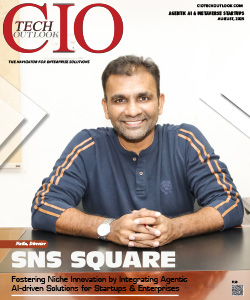Cloud-Ready Linux, AI-Powered Tools, and Software-Defined Vehicle Breakthroughs
Grena, Correspondent, CIOTechOutlook | Wednesday, 25 June 2025, 12:44 IST
 As the digital world rapidly evolves toward being cloud-native and more AI-powered, global technology companies are also moving to refactor their products to meet the demands of modern enterprises. In this transitional space, large open source solutions provider Red Hat is ongoing to reinforce its position at the intersection of cloud computing, artificial intelligence, and enterprise security. At Red Hat Summit 2025, Red Hat showcased its innovation within virtualization, hybrid cloud, AI integration, and enterprise security - illustrating its approach to building a smart, scalable, and collaborative open source future-ready ecosystem.
As the digital world rapidly evolves toward being cloud-native and more AI-powered, global technology companies are also moving to refactor their products to meet the demands of modern enterprises. In this transitional space, large open source solutions provider Red Hat is ongoing to reinforce its position at the intersection of cloud computing, artificial intelligence, and enterprise security. At Red Hat Summit 2025, Red Hat showcased its innovation within virtualization, hybrid cloud, AI integration, and enterprise security - illustrating its approach to building a smart, scalable, and collaborative open source future-ready ecosystem.
From launching a cloud-optimal version of Red Hat Enterprise Linux to integrating AI-assisted tools for enterprises and moving into the automotive sector with its safety certified In-Vehicle Operating System, Red Hat is establishing a future-ready platform ecosystem. Red Hat is also further establishing its connections with major industry players such as Meta, AMD, Microsoft, and Google Cloud to collectively openly collaborate, advance artificial intelligence, and provide large-scale and secure solutions for future enterprise needs.
Cloud-Optimized Red Hat Enterprise Linux:
At Red Hat Summit 2025, Red Hat launched a new version of Red Hat Enterprise Linux (RHEL) specially designed for use on major cloud platforms like AWS, Microsoft Azure, and Google Cloud. These versions are easier to use, faster to set up, and come pre-configured in partnership with the cloud providers. They help businesses run more efficiently in the cloud, with consistent performance, better monitoring tools, and stronger security features like data protection and system checks. The new cloud-friendly RHEL is now available through subscriptions or directly from the cloud providers' marketplaces.
Mangesh Surve, Sr.Director – Technology Solutions Architecture, Red Hat, said, “We’re not adding anything proprietary, but what we bring is a pre-integrated, stable version of open source projects, so customers don’t have to struggle with integration and version mismatches. That’s the value Red Hat delivers.”
AI-Powered assistant, Ask Red Hat, built on open innovation introduced by Red Hat Customer Portal:
Red Hat recently added Ask Red Hat, an AI-powered assistant, to its Customer Portal. This smart chatbot helps users navigate the portal, quickly find solutions to setup issues, troubleshoot errors, understand security alerts, and even connect with human support. Built with Red Hat’s open source AI stack (Granite, Llama Stack, and OpenShift AI), it draws from the full knowledge base and guides users in 12 languages, including Arabic, Chinese, and Spanish. Ask Red Hat simplifies finding the right documentation or tools and is available now to all Red Hat subscribers through the portal.
A new future of SDV with upcoming general availability of Red Hat In-Vehicle OS:
Red Hat has announced that its new “In-Vehicle Operating System”, built on Red Hat Enterprise Linux, has earned safety certification to the ISO 26262 ASIL-B standard, marking a major step toward software-driven cars. Set to be fully available in Q3 2025, this open source platform is designed for real-world automotive needs like faster startup, reliable response times, and protection so that safety critical functions (like braking or advanced driver-assist systems) stay separate from less critical apps (like entertainment or navigation) Automakers can now develop software in the cloud, test it virtually, and deploy it directly to vehicle hardware without rewriting which simplifying and speeding up the process.
The release also comes with tools and documentation to support safe deployment and includes partnerships with major chip makers such as Renesas and Qualcomm, to ensure the system works smoothly on certified hardware. This helps car manufacturers cut development costs, streamline operations, and embrace a unified, cloud-to-car development model.
Red Hat and Meta Collaborate to Advance Open Source AI for Enterprise:
Red Hat and Meta have teamed up to bring cutting-edge open-source AI into the enterprise, starting with seamless support for Meta’s Llama 4 model on Red Hat AI and the high-performance vLLM inference engine.
Ameeta Roy, Senior Director, Solution Architecture and CTO, Red Hat India/SA, said, "We're infusing AI into every product—so whether you're a novice or an expert, you get smart assistance right at the command line."
This partnership aims to create unified frameworks such as the Llama Stack and the vLLM community project that simplify building and running generative AI workloads across different clouds, hardware, and environments. With “day 0” readiness for Llama 4 and strengthened collaboration around open APIs and standards, the two companies are working to ensure faster, more consistent, and cost-effective deployment of AI applications in business settings.
Red Hat Advanced Developer Suite:
Red Hat has introduced Advanced Developer Suite, a powerful new add-on to OpenShift designed to help developers build applications faster and more securely, with support for AI built in. It includes a central portal where teams can access ready-to-use templates, tools, and best practices (including AI-based ones), making onboarding and development smoother. Security is a core focus: it offers automated checks for vulnerabilities, supply-chain risk insights, and digital signing of code and AI models to ensure only trusted software is used. Developers can also work locally or in the cloud using pre-configured environments, and it easily fits into existing CI/CD workflows to speed up testing and delivery.




.jpg)